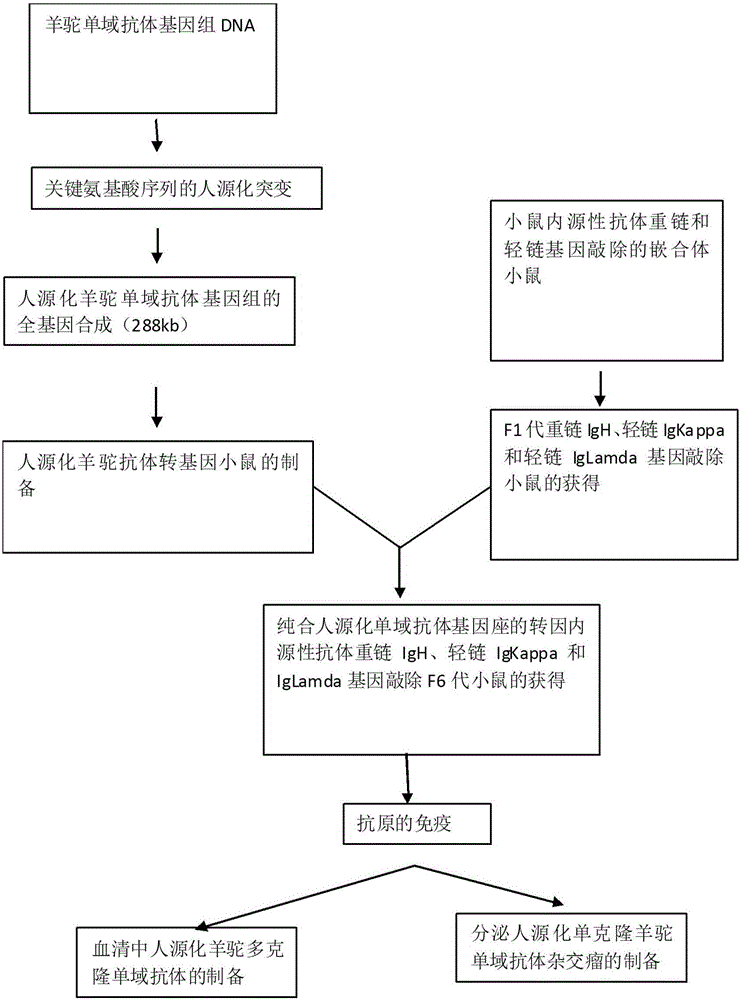Method for preparing humanized camelidae single-domain antibody through transgenic rodent
A single-domain antibody, rodent technology, applied in the fields of molecular biology and immunology, which can solve the problems of the influence of the antigen-binding activity of antibody molecules
- Summary
- Abstract
- Description
- Claims
- Application Information
AI Technical Summary
Problems solved by technology
Method used
Image
Examples
Embodiment 1
[0038] 1. Humanized design of alpaca VHH gene
[0039] We selected 13 core sequences of single domain antibody genomic DNA with known sequences. By comparing with the sequence of the variable region of the human antibody heavy chain, we humanized their framework region sequence, and the nucleotide coding sequence after mutation As shown in SEQ ID NO:1-13, the humanized sites are as shown in Table 1.
[0040] Table 1. List of VHH gene humanized modification sites
[0041]
[0042] Then these humanized VHH core sequences are randomly connected using conventional molecular biology techniques, or a large DNA molecule is directly synthesized by DNA synthesis to form a single domain antibody upstream variable region DNA containing only the VHH sequence. Sequence combination. The sequence of the series in this experiment is in the order 1-13 of the number in the table above, but it can be connected in any random order, and the sequence of the series does not affect the acquisition of the ...
Embodiment 2
[0078] Example 2: Detection of alpaca single domain antibody in transgenic mice:
[0079] Take 100 microliters of blood from the mouse's orbit using a capillary tube, place it at room temperature for 1-2 hours to coagulate the blood, and centrifuge at 2000 rpm at 4 degrees for 10 minutes to separate the serum. Take the upper layer of serum and place it in a clean 1.5 ml centrifuge tube, store it at 4°C for later use.
[0080] Apply 100 microliters of rabbit anti-alpaca antibody (ab173185) diluted 1:100 at 4°C to 96-well ELISA plate overnight. After washing with PBST, add 1:10 diluted transgenic mouse serum and bind for 1 hour at room temperature. PBST Wash 3-5 times, add 100 microliters of HRP-labeled goat anti-alpaca antibody (ab112786) diluted 1:5000, react at room temperature for 1 hour, wash 3-5 times with PBST, add 100 microliters of TMB substrate, react at room temperature After 15 minutes, add 50 microliters of 2N sulfuric acid, and use a microplate reader to detect the abs...
Embodiment 3
[0081] Example 3: Preparation of humanized alpaca single domain antibody hybridomas secreted by transgenic mice and cloning and identification of single domain antibody genes
[0082] 1. Extraction of B cells from transgenic mice:
[0083] 1.1 Immunization of mice: Take 6-8 weeks old female transgenic mice, mix 100ug of chicken egg white lysozyme antigen and Freund's complete adjuvant, and then subcutaneously immunize once, and mix 100ug antigen with Freund's incomplete adjuvant at 2 weeks interval After subcutaneous immunization 2 times, intravenous booster immunization 2 weeks later, 3 to 5 days later for fusion.
[0084] 1.2 Preparation of spleen cells: the immunized transgenic mice were sacrificed by the neck, the body was disinfected with alcohol, the spleen was taken out under aseptic conditions, the connective tissue and fat were shaved, and washed once with 5ml serum-free culture medium.
[0085] 1.3 Put the spleen in a sterilized 90-100 mesh stainless steel mesh or nylon gauz...
PUM
| Property | Measurement | Unit |
|---|---|---|
| length | aaaaa | aaaaa |
| width | aaaaa | aaaaa |
Abstract
Description
Claims
Application Information
 Login to View More
Login to View More - R&D
- Intellectual Property
- Life Sciences
- Materials
- Tech Scout
- Unparalleled Data Quality
- Higher Quality Content
- 60% Fewer Hallucinations
Browse by: Latest US Patents, China's latest patents, Technical Efficacy Thesaurus, Application Domain, Technology Topic, Popular Technical Reports.
© 2025 PatSnap. All rights reserved.Legal|Privacy policy|Modern Slavery Act Transparency Statement|Sitemap|About US| Contact US: help@patsnap.com



